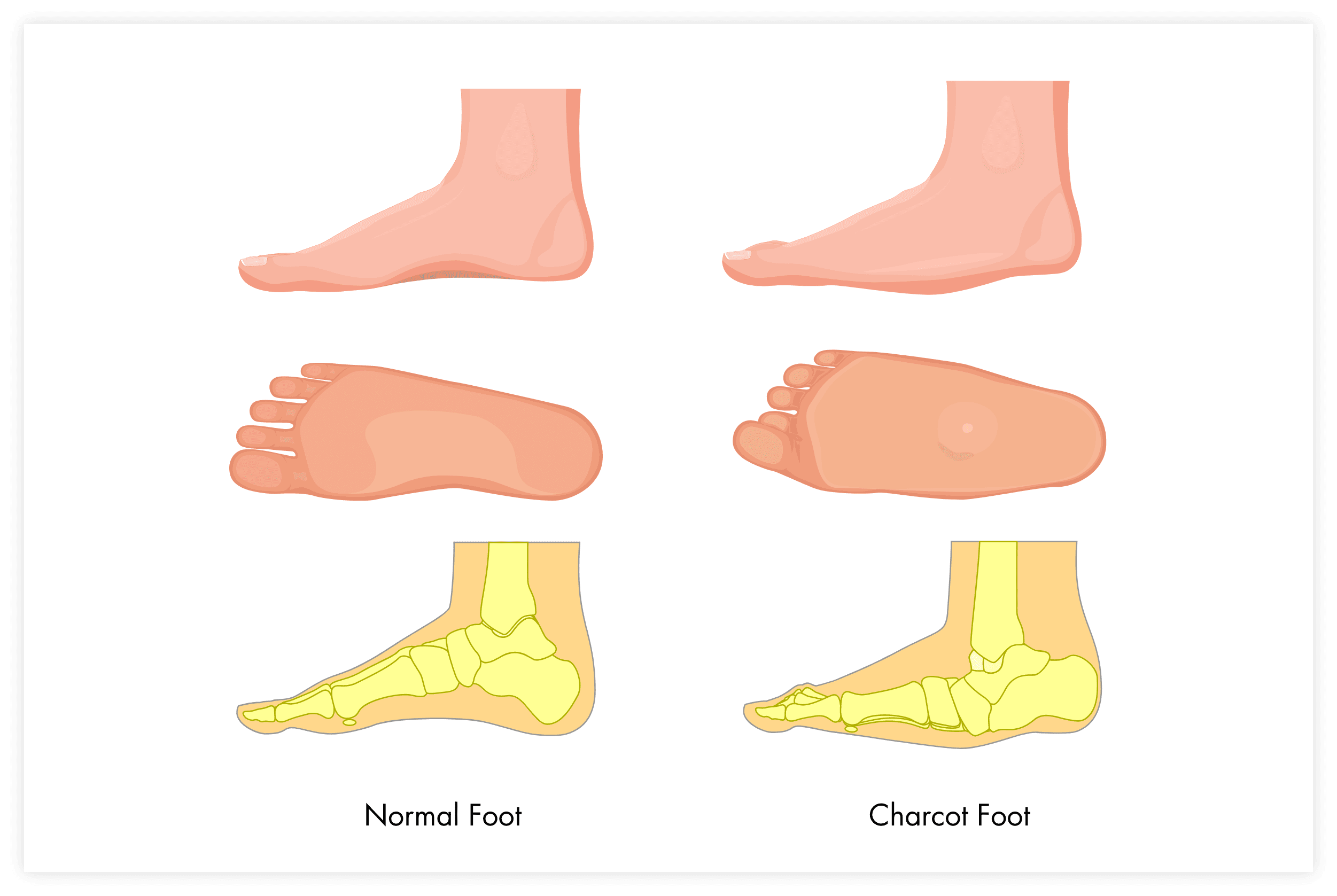
Charcot Explained
A Neuropathic Disorder
Charcot disease can be a serious neuropathic condition (a nerve problem that causes pain, numbness, tingling, swelling, or muscle weakness in different parts of the body) that may affect people of all ages. It may occur anywhere in the body, but often affects the lower extremities. Charcot in the foot or ankle is defined by a sudden softening of the bones that can trigger an avalanche of problems including joint loss, fractures, arch collapse, deformity, and ulcer formation. If left untreated, Charcot complications can lead to amputation.1
Charcot can be found in different areas of the lower leg, but most commonly affects the midfoot and ankle.2


Rocker Bottom Foot
As Charcot foot progresses, the bottom of the foot can become rounded, bulging like the hull of a ship.1 Because of its appearance, your healthcare provider may refer to this as a "rocker bottom".
Charcot Causes
There is still a lot to learn about what leads to Charcot in the foot and ankle, but it is thought to be caused by repetitive injury or trauma that builds-up over time. It's an unfortunate cycle. The continued stress placed on the foot through this repeated trauma ends up dulling the nerves in the foot, which in turn makes the condition worse because the pain goes unnoticed. The longer someone has neuropathy (significant nerve damage), the higher the risk they have for developing Charcot in the foot and ankle.3
Charcot in the foot and ankle is often the result of uncontrolled diabetes and is sometimes referred to as "diabetic foot"4:
- First, poor blood supply to the nerves dulls sensation in the foot, making diabetics less likely to feel foot injuries.
- Second, the lack of blood being supplied to the skin and the foot makes the healing process more difficult. Because of this sensation, diabetic patients are more likely to get wounds and the wounds they do get are less likely to adequately heal. Unattended wounds allow bacteria to enter the foot, leading to diabetic foot infections.
- If you are suffering from neuropathy, you may even sustain fractures or dislocations in the foot without even realizing it.
Understanding the origins of your Charcot foot is important to understanding your treatment next steps. Beyond diabetes, Charcot in the foot and ankle can develop through sprains or broken bones if the injury goes untreated due to a lack of sensation caused by nerve damage. Obvious traumatic events such as falls and injuries sustained in accidents can be contributing factors.5 Other causes include alcoholism or drug abuse, infection, spinal cord injury, various neurological diseases and conditions, steroid intake, and heavy-metal poisoning.6
Symptoms

The telltale signs of Charcot often come on suddenly, making management tricky.1 Some common symptoms include:

Warmness to the touch, redness, and swelling in the foot or ankle.3

Persistent pain or soreness

Visual deformity, such as the "rocker bottom" appearance to the foot

Loss of protective sensation5

Ulcer formation, especially those slow to heal
Ulcers that form as result of a Charcot deformity in the foot or ankle are a major risk factor for amputation and should be treated promptly.
Diagnosis
Charcot in the foot and ankle can be difficult to diagnose, and misdiagnosis is not uncommon.1
Because diagnosis can be difficult, a careful examination from a qualified foot and ankle surgeon is often necessary to confirm the condition. In addition to the examination, this expert will likely conduct a detailed review of your medical history and evaluate other factors that may contribute to the condition, including:
- Resistance to antibiotic treatments
- X-rays or other diagnostic imaging that show disruption to your body
- Recurring or longstanding wounds
While Charcot is not reversable, the speed at which the disease progresses may be managed or slowed, and more serious outcomes may be avoided if addressed by a healthcare provider in a timely manner. Foot and ankle specialists may utilize the latest technologies and medical techniques, while leaning on the expertise from your team of specialists, to work to prevent amputation.
LEARN MOREReferences
- Rare Diabetes Foot Complication Becoming More Common - Foot Health Facts; American College of Foot and Ankle Surgeons (ACFAS). (n.d.). www.foothealthfacts.org. Retrieved August 8, 2022, from https://www .foothealthfacts.org/article/rare-diabetes-foot-complication-becoming-more-comm#
- Young, M. J., Breddy, J. L., Veves, A., & Boulton, A. J. (1994). The prediction of diabetic neuropathic foot ulceration using vibration perception thresholds. A prospective study. Diabetes care, 17(6), 557–560. https://doi.org/10.2337/diacare.17.6.557
- Charcot Foot - Foot Health Facts; American College of Foot and Ankle Surgeons. (n.d.). www .foothealthfacts.org. https://www.foothealthfacts.org/conditions/charcot-foot
- Diabetic (Charcot) Foot. (2022); OrthoInfo; American Academy of Orthopaedic Surgeons. https://orthoinfo .aaos.org/en/diseases--conditions/diabetic-charcot-foot/
- Singh N, Armstrong DG, Lipsky BA. Preventing foot ulcers inpatients with diabetes. JAMA 2005; 293:217–28.
- Kaynak G, Birsel O, Guven FM. (2013). An overview of the Charcot foot pathophysiology. Diabetic Foot & Ankle. https://doi.org/10.3402/dfa.v4i0.21117.
Important Information
Individual results and activity levels after surgery vary and depend on many factors including age, weight, and prior activity level. There are risks and recovery times associated with surgery, and there are certain individuals who should not undergo surgery. Only a physician can tell you if this product and associated procedure are right for you and your unique circumstances. Please consult with a physician for complete information regarding benefits, risks, anticipated implant duration and possible outcomes.
AP-016836